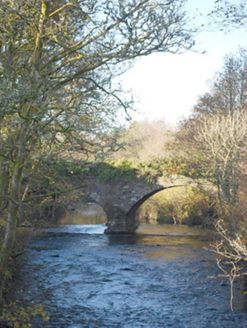Survey Data
Reg No
40829003
Rating
Regional
Categories of Special Interest
Architectural, Technical
Original Use
Bridge
In Use As
Bridge
Date
1760 - 1800
Coordinates
212326, 409121
Date Recorded
10/11/2010
Date Updated
--/--/--
Description
Double-arched bridge carrying road over the River Swilly, built c. 1780, having V-profile ashlar cutwaters to the central pier to both upstream and downstream elevations with having projecting cut stone stringcourse over running through arch barrels. Segmental-headed arches having dressed cut stone; rubble stone construction to the arch barrels. Squared and coursed rubble stone construction to pier, spandrels, and parapets. Stone coping to parapets with modern repairs in places; parapets now overgrown. Located in the rural countryside to the south-west of Letterkenny. Newmills corn mill (see 40829001) adjacent to the south-east of bridge.
Appraisal
This appealing double-arch bridge retains its early character and form, and is an appealing feature in the scenic rural landscape to the south-west of Letterkenny. It is robustly-constructed in local rubble stone masonry, and its continued survival and use stands as testament to the quality of its original construction, and of the skill of the masons involved. The two graceful wide arches with dressed voussoirs, the ashlar cutwaters, and the cut stone stringcourses at arch springing point are interesting features that add some aesthetic merit that helps to elevate this bridge above many of its contemporaries in County Donegal. This bridge probably dates to the end of the eighteenth century, a period that saw a great deal of road and bridge-building in Ireland, particularly by the Grand Juries (the forerunners of the County Councils). This appealing bridge is an integral element of the built heritage and transport heritage of the local area, and makes a positive contribution to the landscape. Located adjacent to Newmills corn mill (see 40829001) and flax mill (see 40829002), this bridge contributes positively to a collection of buildings that are of high heritage value.

